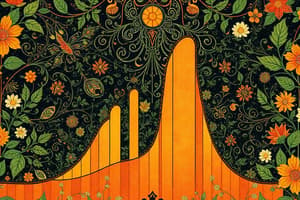Podcast
Questions and Answers
What is the mathematical outcome when you subtract the mean from each value in a dataset?
What is the mathematical outcome when you subtract the mean from each value in a dataset?
- The resulting values will always sum to the mean.
- The sum of the resulting values will always equal zero. (correct)
- The sum of the resulting values will equal the total number of values.
- The resulting values will represent the original data points.
Why is division important in calculating the mean of a dataset?
Why is division important in calculating the mean of a dataset?
- It enables the elimination of outliers in the dataset.
- It allows for multiplication of each value.
- It ensures that all data points have an equal influence on the average. (correct)
- It changes the distribution of the data points.
What does a low standard deviation indicate about a dataset?
What does a low standard deviation indicate about a dataset?
- The values are widely spread out from the mean.
- The values are concentrated near the mean. (correct)
- The values are consistently below the mean.
- The values are all identical to the mean.
What happens to the sum of deviations from a number chosen at random rather than the mean?
What happens to the sum of deviations from a number chosen at random rather than the mean?
How is the variance calculated in relation to the standard deviation?
How is the variance calculated in relation to the standard deviation?
What is the fundamental property of the mean regarding deviations?
What is the fundamental property of the mean regarding deviations?
When computing the mean of a set of numbers, what role does each number play?
When computing the mean of a set of numbers, what role does each number play?
What is the main purpose of finding the average in a dataset?
What is the main purpose of finding the average in a dataset?
In the context of statistics, what does the term 'dispersion' refer to?
In the context of statistics, what does the term 'dispersion' refer to?
What ordinary mathematical operation is pivotal in calculating the mean?
What ordinary mathematical operation is pivotal in calculating the mean?
What does it mean when data points have a high standard deviation?
What does it mean when data points have a high standard deviation?
Why is the mean described as a point of balance in a dataset?
Why is the mean described as a point of balance in a dataset?
How does the division in the mean calculation relate to equitable resource distribution?
How does the division in the mean calculation relate to equitable resource distribution?
What is an essential characteristic of the mean compared to other statistics?
What is an essential characteristic of the mean compared to other statistics?
What does dividing by the total number of individuals help to determine?
What does dividing by the total number of individuals help to determine?
What does the square root of the average variation represent?
What does the square root of the average variation represent?
Why is it important to convert differences to positive values when calculating dispersion?
Why is it important to convert differences to positive values when calculating dispersion?
When calculating the average of absolute deviations, what does redividing by the number of individuals yield?
When calculating the average of absolute deviations, what does redividing by the number of individuals yield?
What does a sum of zero signify when calculating differences from the mean?
What does a sum of zero signify when calculating differences from the mean?
How does the distribution of data points relate to the concept of mean as a point of balance?
How does the distribution of data points relate to the concept of mean as a point of balance?
What is the rationale behind calculating the mean as the center of a dataset?
What is the rationale behind calculating the mean as the center of a dataset?
What is the purpose of averaging the differences of each data point from the mean?
What is the purpose of averaging the differences of each data point from the mean?
What does measuring dispersion around the mean generally help us understand?
What does measuring dispersion around the mean generally help us understand?
Which statistical measure is typically used to understand the variations in data around the mean?
Which statistical measure is typically used to understand the variations in data around the mean?
What happens when both positive and negative deviations from the mean are not converted to absolute values?
What happens when both positive and negative deviations from the mean are not converted to absolute values?
What is the unique property of the mean?
What is the unique property of the mean?
How is the mean calculated?
How is the mean calculated?
What happens when another number, not the mean, is chosen as a central point?
What happens when another number, not the mean, is chosen as a central point?
What do the positive deviations from the mean represent in a practical scenario?
What do the positive deviations from the mean represent in a practical scenario?
What is the significance of the total sum of positive and negative deviations?
What is the significance of the total sum of positive and negative deviations?
In the cake redistribution example, what does the average of absolute deviations represent?
In the cake redistribution example, what does the average of absolute deviations represent?
What physical analogy is used to explain the concept of the mean?
What physical analogy is used to explain the concept of the mean?
Why can the mean be seen as 'absorbing' differences among data?
Why can the mean be seen as 'absorbing' differences among data?
Which of the following statements about the mean is false?
Which of the following statements about the mean is false?
In the redistributing cake example, what does a positive value of deviation (Di − d̄) indicate?
In the redistributing cake example, what does a positive value of deviation (Di − d̄) indicate?
What does balancing a dataset around the mean ensure?
What does balancing a dataset around the mean ensure?
How does the mean relate to the concept of conservation in an example like cake distribution?
How does the mean relate to the concept of conservation in an example like cake distribution?
What role do individual contributions play when calculating the mean?
What role do individual contributions play when calculating the mean?
Why is the mean considered a 'pivot' point?
Why is the mean considered a 'pivot' point?
Flashcards
Standard Deviation
Standard Deviation
A measure of how much data points vary around the mean (average).
Mean
Mean
The average of a set of data.
Variance
Variance
Average of squared deviations from the mean.
Deviation
Deviation
Signup and view all the flashcards
Low Standard Deviation
Low Standard Deviation
Signup and view all the flashcards
High Standard Deviation
High Standard Deviation
Signup and view all the flashcards
Data Set
Data Set
Signup and view all the flashcards
Calculating Standard Deviation
Calculating Standard Deviation
Signup and view all the flashcards
Sum of Squared Deviations
Sum of Squared Deviations
Signup and view all the flashcards
Average of Squared Deviations
Average of Squared Deviations
Signup and view all the flashcards
Risk Measurement
Risk Measurement
Signup and view all the flashcards
Data Spread
Data Spread
Signup and view all the flashcards
Predictability
Predictability
Signup and view all the flashcards
Data Consistency
Data Consistency
Signup and view all the flashcards
Statistical Analysis
Statistical Analysis
Signup and view all the flashcards
Fields Using Standard Deviation
Fields Using Standard Deviation
Signup and view all the flashcards
Squared Deviations
Squared Deviations
Signup and view all the flashcards
Data Points
Data Points
Signup and view all the flashcards
Excess/Shortfall
Excess/Shortfall
Signup and view all the flashcards
Average Candies
Average Candies
Signup and view all the flashcards
Balance Point
Balance Point
Signup and view all the flashcards
Number of Data Points
Number of Data Points
Signup and view all the flashcards
Candy Example
Candy Example
Signup and view all the flashcards
Study Notes
Understanding Standard Deviation
- Standard deviation is a complex concept to understand because of its formula, but a simple example can help.
- Imagine 5 people having 2, 3, 4, 5 and 6 candies, respectively.
- Average candy distribution is 4 candies per person.
- Some people have more candies (excess) while others have fewer candies (shortfall).
- Excess/shortfall is calculated by subtracting average candies from the candies each person has.
- The standard deviation is a measure of how much the data points in a set vary around the mean.
- In the candy example, the standard deviation is calculated by taking the square root of the variance.
- Variance is the average of the squared deviations (excess/shortfall) of each data point from the mean.
- To calculate variance, you divide the sum of the squared deviations by the number of data points, which is equivalent to calculating the average of the squared deviations.
- To understand the concept of standard deviation, we need to understand that it is a measure of how much data points deviate from the average.
- The average is the point of balance for the data set.
- When we subtract each data point from the average, the positive and negative deviations cancel each other out, resulting in a sum of zero.
- That is because the average is the point where the sum of all deviations is zero.
- Therefore, to measure the dispersion of the data (i.e., the spread of data around the average), we need to use a measure that takes into account the deviation from the average.
- The standard deviation is that measure.
- It is calculated by taking the square root of the variance, which is the average of the squared deviations from the mean.
- The standard deviation is an important concept in statistics because it tells us how much data points vary around the average.
- A low standard deviation means that the data points are clustered closely around the average.
- A high standard deviation means that the data points are spread out more widely.
- The standard deviation is a useful tool for understanding the variability of data.
- Standard deviation is used in various fields like finance and engineering, among others, where the spread and predictability of data matter.
- Standard deviation is also commonly used in measuring risk.
Studying That Suits You
Use AI to generate personalized quizzes and flashcards to suit your learning preferences.



